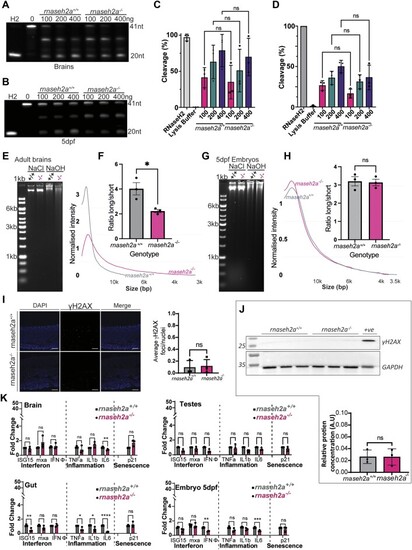
rnaseh2a−/− adult fish have a high incorporation of ribonucleotides but no increased inflammatory response. (A) RNaseH2 activity assay on brains from adult fish. (B) Activity assay of 5dpf embryos. (C) Quantification of cleavage assay on brains, ±SD, one way ANOVA, P <0.05, n = 3. (D) Quantification of cleavage activity of d5 embryos, ±SD, one way ANOVA, P <0.05, n = 3. (E) Alkaline treatment of DNA from brains from adults shows an increase of ribonucleotides in homozygote adults, as shown by smearing on a gel. (F) Quantification of alkaline treatment of adult brains. Image analysis shows that the ratio of long to short DNA fragments is significantly reduced in adult rnaseh2a−/− brains. Student's t-test, n = 3 ± SEM, *P< 0.05. (G) Alkaline treatment of DNA from on 5dpf embryos showing no increase in DNA smearing in homozygous embryos. (H) Quantification of alkaline treatment of 5dpf embryos. Student's t-test, n = 3 ± SEM. (I) γH2AX staining 5dpf embryo tails from a heterozygous incross. Quantification of foci per nuclei shows no significant difference between rnaseh2a−/− and rnaseh2a+/+ siblings. Student's t-test, n = 3, P <0.05. (J) Western blot for γH2AX in brain samples from individual adult zebrafish. Quantification showed no significant difference between rnaseh2a−/− and rnaseh2a+/+ siblings. Student's t-test, ±SD, P <0.05. n = 3. (K) Expression of interferon stimulated genes (ISG15, mxa and IFNphi), inflammatory response genes (TNFα, IL1β and IL6) and senescence markers (p21) were measured in tissues isolated from rnaseh2a-/- 19 month adults and in 5dpf rnaseh2a-/- embryos from a heterozygous incross. Multiple unpaired t-tests with Welch correction, *P <0.05, **P <0.01. ***P <0.001, ****P <0.0001, ±SD (n = 3).
|